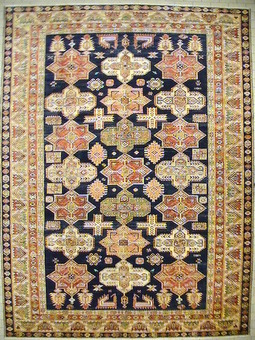Handmade oriental carpet No. 57000 Kuba Caucasus 378 x 273 cm

Larger images (will open in new window)
Please click on the thumbnails below for a larger view
| main view |
close-up border |
close-up |
 |
 |
 |
| Item Number: |
57000 |
| Name: |
Kuba |
| Country of Origin: |
Caucasus |
| Size: |
378 x 273 cm |
| Age:
|
Sorry, we can't give you the age of this carpet at the moment. |
| Pile: |
wool |
| Design: |
geometric / allover |
| Ground Color: |
dark blue / navy |
| Knots per sqm: |
150,000 |
| Remarks: |
This is a unique handmade / hand-knotted / traditional oriental carpet
The pile of this carpet is made of wool
Very fine piece
This carpet has a total of approximately 1,548,000 knots and it took skilled carpet makers about 2,064 hours or 229 working days to hand-knot this carpet. |
 add to cart
add to cart
More about the provenance Kuba | Caucasus
Within the Caucasian rugs, the group of Kuba rugs (not to be mistaken for Castro's Cuba) belong to the best and most desired Caucasian rugs. The characteristics of Kuba rugs are fineness, low pile, fine patterns and beautiful colors which together create a harmonious general picture. Kuba rugs come from the city of Kuba in South East Caucasia, in the north verging on the Shirvan area. The following Caucasian provenances belong to the group of Kuba rugs amongst others: Konakgend, Perepedil and Sejshour. Typical designs: a field with geometric motifs, stars and polygons, often also geometric arabesques. Only best quality wool has been used and is still being used on Caucasian productions.
This is an Oriental nomadic rug. The word "nomad" comes from the Greek word "nemein". Nomads are wandering tribes, shepherds, stockbreeders, or hunters. In the minorly populated areas of Asia and North Africa they move with their herds, all their belongings and their tents to new places constantly. Many states already tried to make them settle down with various success. Mostly it is the women of the tribes which contribute to the family's income with their carpet knotting and weaving while the men breed stock or go hunting. But due to the circumstances of nomadic life the carpet production often lacks regularity and precision in form and design, which actually adds to their originality and makes them even more popular. The wool is mostly dyed with vegetable dyes.

